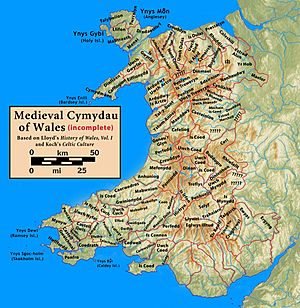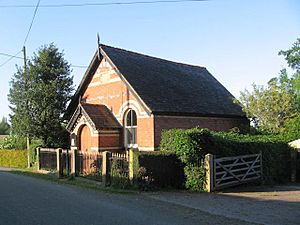Deuddwr facts for kids
Deuddwr was a small area of land in medieval Wales. Its name means "two waters" in Welsh. It was called this because it was located where two important rivers, the River Vyrnwy and the River Severn, met.
Deuddwr was a type of district known as a commote (pronounced COM-oat). A commote was a local area within a larger region called a cantref (pronounced CAN-trev). Deuddwr was part of the cantref of Ystlyg, which was in the Kingdom of Powys.
Where Was Deuddwr?
Deuddwr was located in the eastern part of the Kingdom of Powys. It shared a border with England to the north. To its northwest was the cantref of Mechain. Within its own larger region of Ystlyg, Deuddwr bordered other commotes: Ystrad Marchell to the south and Y Gorddwr to the east.
As its name suggests, Deuddwr was nestled between the River Vyrnwy in the northeast and the River Severn in the southeast. These two rivers joined together at the eastern edge of the commote.
Later on, the area of Ystlyg (not including Y Gorddwr) became known as a "hundred" called Deuddwr. A hundred was another type of land division used in England and parts of Wales. Over time, the name of this hundred changed slightly to Deythur or Deytheur. You can still find the name Deuddwr in modern places, like the parish of Llansantffraid Deythur and a village called Deuddwr near Llansantffraid-ym-Mechain.
Deuddwr's Place in History
Deuddwr was an important area in the 13th century. It was one of three special commotes, sometimes called the Teirswydd ("three commotes"). The other two were Llannerch Hudol and Ystrad Marchell.
In 1263, these three commotes were given back to a Welsh prince named Gruffydd ap Gwenwynwyn. This happened after he showed his loyalty and support (called "homage" and "fealty") to another powerful Welsh leader, Llywelyn ap Gruffudd. This agreement took place at a place called Ystumanner.



